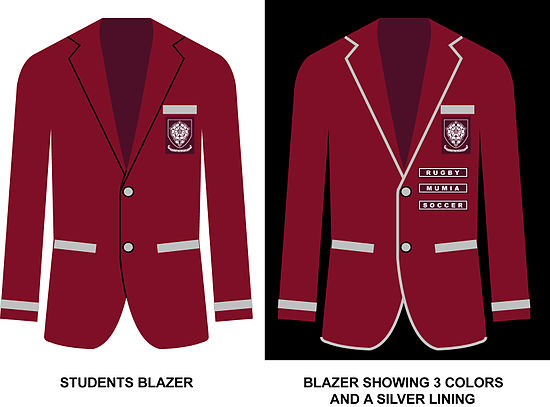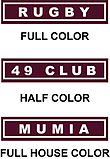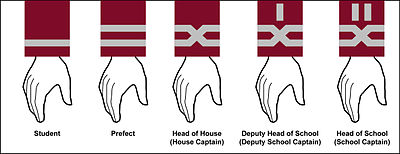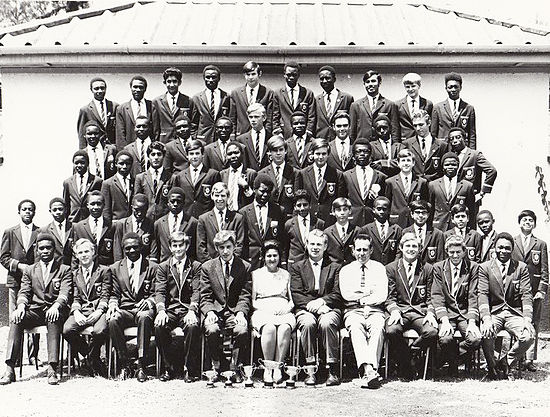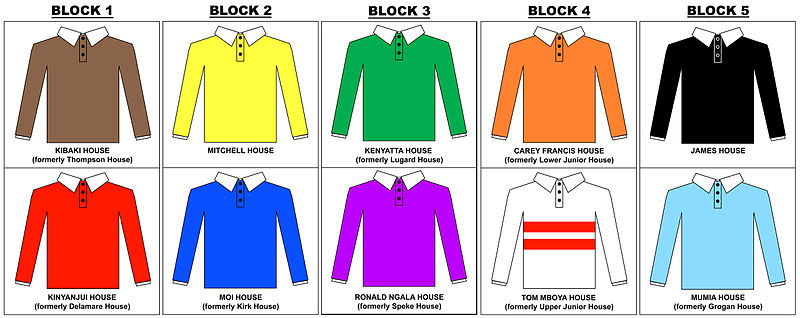- Lenana School
-
Lenana School  Nihil Praeter Optimum (Nothing But The Best)
Nihil Praeter Optimum (Nothing But The Best)Location Nairobi, Kenya Coordinates 1° 18' 0.957" S, 36° 43' 41.775" E [1] Information Type National, Public Established 1949 Head teacher Mr. P. W. Warui Number of students 1030 Campus Karen, Nairobi Color(s) Maroon, Grey and White whiterose Lenana School is a high school in Nairobi, Kenya. It was formed in 1949 by colonial governor Philip Euen Mitchell in 1949, known then as the Duke of York School (the actual bell from HMS Duke of York (17) can still be seen mounted at the front school parade ground between the school chapel and the hall). The first students were briefly housed at the then British colonial Governor's House which is the current State House as they waited for the school's completion. The founding principal/headmaster was R.H. James.
Originally the school was reserved for white students only within the racial system of colonial Kenya Colony. All teachers (masters, as they were called at the time), were also white. The students were drawn from the sons of British settlers, most of whom were farmers in outlying areas. This required a primarily boarding facility for the students, although originally there were a few “day” students who came daily. The school system was modeled after the English “public school” system.
By the early 1960s the school was fully developed with its own well kept 9 hole golf course, rifle range, horse stables, a cricket oval with a cricket pavilion and ample sports fields for rugby, football, hockey, swimming, tennis, squash, and other sports. The astronomy club as well endowed with telescopes, the science labs well equipped, and off site school facilities provided for sailing, mountain climbing and other distractions most of which are still available to date. The school had its own water supply from boreholes, and its own sewage treatment plant which were still in operation well into the late 1980s. A large contingent of resident “subordinate” staff were housed on the campus, and saw to the well-being of the faculty and students. They provided all janitorial, laundry, dining, groundskeeping and similar labor, leaving the students free to pursue learning and leisure activities. The main railway line from Nairobi city to western Kenya passes along the front border of the school passing over a bridge (nicknamed The Cassandra Crossing) which marks the front gate of the school. During the colonial era the train would drop off and pick up students going or coming from the school holidays.
After Kenya's independence in 1963 there were gradual changes that led to the first few black and Asian students being admitted in the mid 1960s. These pioneer students were subjected to severe conditions and discrimination as they opened the doors to other Kenyans to come behind them. Black teachers began to be employed in the early 1970s and were similarly subjected to difficult circumstances.
The school was renamed Lenana School in 1967 after the legendary Laibon Lenana who was the central human figure in the Maasai religious system and ruled around the end of the 19th century through to the early 20th century. The first Kenyan headmaster (principal) of the school was Mr. James Kamunge. The referral to old students of the school changed from the phrase "Old Yorkist" to "Laibons" the latter being a title given to the religious head of the Maasai. A picture of the Laibon Lenana painted by a student artist called Sam Madoka can be seen hanging next to the steps that lead to the 2nd floor of the administration block.
Lenana School currently has 1200 students. In 2006, it was ranked 26th best high school in Kenya based on Kenya Certificate of Secondary Education results.[2] Through the 1980s and into the 21st century, Lenana School has maintained high academic standards ranking in the top 10 and top 20 respectively for many years in the 1980s.
The current School principal is Mr. Peter Wanjohi Warui who is deputised by Mr. Silas Wandera.Contents
School Motto
- Nihil Praeter Optimum, Latin for 'Nothing But The Best'
School Anthem
Thought and deed shall bide with tasks
Keep the Rose bright ye our emblem
Sieve the trash dear Lord we ask
For Nihil Praeter Optimum
In pride we ride
With rules abide
As all the boys and staff combine
All members here in Lenana
We aim at Nothing But The Best.Nihil Praeter Optimum
Set for all opportunities
We all come to be well spun
By wide responsibilities
With class and sports
and much in both
For moral health and bodies growth
For gaining here in Lenana
The best and Nothing But The Best.Nothing but the best we stress
For our peace, love and unity
Let us join our land’s progress
And Kenya’s firm stability
O lets enjoy our leadership
And thank the Lord whom we worship
As boys stride on through Lenana
Achieving Nothing But The Best.Academics
Lenana School is categorized as a National school, meaning it recruits students from all over the country who do well in the Kenya Certificate of Primary Education (K.C.P.E) examination. Its nationwide recruitment objectives means that each entering class of fresh students is large and extremely diverse having representatives from all over the country. The classes offered run the full gamut of sciences and arts as well as life skills classes for the students thus inclined. The curriculum might be considered heavy on the sciences but equal attention is paid to providing the students with extensive humanities classes ensuring that all benefit from a well-rounded experience and maximum opportunities for life after high school. The school routinely has a good showing in the Kenya Certificate of Secondary Education (KCSE) nationwide and is consistently ranked highly in its category of schools with large enrollment.[3] [4] Students graduating from Lenana School go on to pursue a myriad of careers.
The old education system (O Level and A Level system) consisted of first form to sixth form students. first form to fourth form had four streams of classes with approximately 40 students each. The subjects done in first form to second form were English Literature, Mathematics, Geography, History, Biology, Physics, Chemistry, Music, Fine Art, Swahili, French, Wood Work and Metal Work (the wood and metal work classes were taken in alternating years of form 1 and form 2 respectively). Fifth form and sixth form were divided in the particular subjects the students took i.e. sciences and arts. In fifth form and sixth form a student could take either 3 or 4 subjects with suitable combinations being determined by the school on selection.
Extracurricular activities
Being a boarding school, extracurricular activities play a huge part in the day-to-day of the student. To this end, there is no shortage of activities into which the students can throw themselves into. Some of these activities are mandated by the school and so time is allotted to the completion of these activities. Community work (not so popularly referred to as Comm work) is designed to empower the student to take charge of maintaining his surroundings, basically janitorial duties performed at early morning hours and extended hours of weekend mornings, except Sunday. Students also participate in drama activities. There are intramural (between houses) competitions in drama, music and all manner of sports that are taken very seriously and from these contests are the school representatives selected to compete externally.
There are a large number of clubs catering to different niches that provide students with opportunities to interact with others of like interest within and without the school. Examples of these clubs include the Commonwealth Club (formerly United Nations Club), the Junior Achievement club (known as J.A), the French Club, the Rifle Club,the St. John Ambulance club, the Boy Scouts, the Duma (prefects' club) and Christian Union, to name a few. From time to time, the school is called upon to host festivals and functions (nicknamed funkies) with invited guests from other schools, near and far. These include Drama festivals/contests, music festivals/contests, Science Congress and many others. School magazines are also a popular activity, be they the formal school newsletter, the Laibon or those of the satirical gossip variety (Scandal, Peep, etc).
Cadet training era
Lenana School had a cadet training course of paramilitary standards in which interested students enrolled. The cadet course was started in the colonial era when Mau Mau activity was at its peak. After the colonial era Lenana went on with the cadet course until it was stopped by the government after the unsuccessful 1982 coup d'etat. The cadet section had uniforms, guns, ammunition, an armoury, a parade ground with adjacent stores and offices and a shooting range. Wednesday afternoons were free of lessons for students so that the cadets could undertake their various training activities. The cadets took part in march pasts during various national days. They also used to be assigned sentry duty at the main gate and around the school at night. Successful cadets who passed out would be issued rank. The cadets, after completion of their form 6 education, could further their careers by joining the armed forces as officer cadets. When the cadet training course was shut down the government collected all the guns and ammunition from the armoury but left the cadet uniforms behind. Once every year until the late 1980s teachers would hold a supervised shooting competition, most of the competitions took place during the school's Founders Day holiday that is celebrated on January 28.
Sports
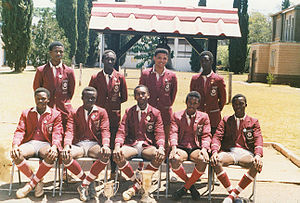 Lenana School 1988 7-a-side rugby squad poses for a team photo in front of the school bell which was recovered from HMS Duke of York (17).
Lenana School 1988 7-a-side rugby squad poses for a team photo in front of the school bell which was recovered from HMS Duke of York (17).
Changez (as Lenana School is known widely for its ability to transform the mannerisms of students from different backgrounds around the country through a strict code of conduct) has a nationwide recruitment tableau bringing in students from all corners of the country. This means that there are as many different sporting activities as there are student backgrounds. Most students come in to Changez having previously been involved in organized sports and for those who have not, they soon get involved in intramural contests. Given the size and the make-up of the student body, there is a heightened competitive nature prevailing within these friendly confines. Facilities are available for many of the sporting activities ranging from rugby and soccer pitches, athletics tracks, hockey fields, cricket pavilion, a gymnasium, tennis and basketball courts, competition-size swimming pool, squash court, wooded terrain (ideal for cross-country), a rifle range and a nine-hole golf course. The inter-house competitions are held with regularity. From these ripe fields are the school's representatives selected. The school always fields competitive teams in soccer, athletics, cross-country, basketball, swimming, hockey, karate and volleyball.
Their rugby is steeped in school tradition and has been a major part of the school's scenery since the school's inception in 1949. Back then the sport (and the school) was the reserve of the elite (predominantly white). Since then Lenana has been one of the four elite rugby schools,[5] winning many accolades, trophies, tournaments and being the only high school team ever to win a championship at club level (see Eric Shirley Shield 1977). The school is always represented in the Kenyan high schools premier rugby league - the Prescott Cup, Damu Pevu Shield, the National Rugby championship, the Blackrock Rugby Festival and all other tournaments open to high school rugby. The school also hosts the John Andrews Memorial 7-a-side Rugby Tournament, in honour of a former student. Many former students have gone on to represent the country on the national team in international tournaments as well as play professionally abroad.[6] The team is known as the 'Mean Maroon' and adorns the maroon jersey emblazoned with the white rose for home meets. A sampling of the rugby team's exploits can be found here.
Color Awards
The school had an awards scheme where students were awarded school or house colors depending on the sport they excelled in. The colors consisted of a piece of maroon cloth approximately 3 inches in length, three quarters on an inch in width and two eighth of an inch thick. It's border and wording in the middle was embroidered with silver or white thread. There were two categories which are full and half colors. If someone was awarded a full color in for example rugby the text on the color would read RUGBY at the recipient would wear it on the left side of his school blazer just below the school badge. If a student acquired three full colors he was awarded a silver lining which was a thick silver or white thread that was sown all around the edge of his blazer. The half colors had the words 49 CLUB (49 being the year the school was founded) embroidered on them, two half colors equaled a full color. Full colors bearing the name of the sport you excelled in could only be awarded at school level. If you were awarded full colors at the house level it could only indicate your house name and not the sport you received it for. House half colors also bore the name 49 CLUB. A silver lining was awarded by the principal.
School Prefects
Apart from the teachers the rules and regulations of the school where dispensed by school prefects. There are two categories of prefects, School prefects and House prefects. The school prefects jurisdiction was the whole school. There were 10 school prefects who were made up of the Head of the 10 houses. From these 10 prefects a Head of School and his deputy were chosen. To distinguish themselves the silver bands near the edge of the arm sleeve of their school blazer was a double band (a normal student had a single band) when the bands reached the outside of the arm sleeve they crossed paths before maintaining the parallel path wrong the sleeve. The head of school had two short vertical strips located just above the crossed band paths and his deputy had one. The other group of prefects was the House prefects. Their jurisdiction was their respective houses and sometimes the block they belonged to. House prefects wore two parallel silver bands that went all around the edge of the arm sleeve.
Blocks/Dorms
There were 5 blocks consisting of 2 houses each. Each house consisted of all the class streams i.e. form 1 to 6 (in the old system) and form 1 to 4 (in the new system). In the old system form 1 to 4 had approximately 18 students each per house and form 5 to 6 had approximately 10 to 12 students each per house. The house was divided into 2 categories, Form 1 to 3 were known as juniors and they had their own sporting leagues. Form 4 to 6 formed the seniors and they too had their separate leagues. When it came to school team selection this was open to both juniors and seniors. Form 1 to 4 students slept in dormitories. Some form 5's slept in the form 4 dorms while the rest and all form 6 students slept in studies either 2 sharing one or in singles e.g. the Head of House and his deputy and the sports prefect.
Each house was governed by a house master who consisted of a senior teacher living adjacent to the house. The student in charge of the house was known as a Head of House (HoH) and was a 6th form student. Assisting him run the house was a deputy head of house and about 5 or 6 other prefects all drawn from the form 6 students. The prefect roles were divided amongst the activities of the house and the most influential being the sports prefect. A new set of prefects was selected towards the end of the year (3rd term) from amongst the form 5 students. Each block of 2 houses shared a dining hall except for Block 1 and 4 where four houses shared one dining hall. Each house had one janitor who took care of the laundry services for the students and the general upkeep of the house.
The dormitories have had some names changed over the course of time. This was done to acknowledge the changing times from the colonial era to independence and the many heroes involved in the independence movement in Kenya, as well as folk heroes. A few of the houses still retain their original names, evidently.
Block 1:
- Kibaki House (formerly Thompson House) - named after the 3rd (and incumbent) President of Kenya Honorable Mr. Mwai Kibaki. The house color is brown.
- Kinyanjui House (formerly Delamare House) - named after Chief Kinyanjui who was a Kikuyu leader during the colonial era leading to the independence. The house color is red.
Block 2:
- Mitchell House - named after the colonial Governor of Kenya at the time when the school was founded, Sir Philip Euen Mitchell. The house color is yellow.
- Moi House (formerly Kirk House) - named after the second President of Kenya (retired), Hon. Daniel arap Moi. The house color is navy blue.
Block 3:
- Kenyatta House (formerly Lugard House) - named after the first President of the Republic of Kenya, Mzee Jomo Kenyatta. The house color is green.
- Ronald Ngala House (formerly Speke House) - named after pre-independence freedom hero and post-colonial politician who campaigned for the rights of the minority tribes, Ronald Ngala. The house color is purple.
Block 4:
- Carey Francis House (formerly Lower Junior House)- named after a colonial era Kenyan nationalist and education pioneer. Carey Francis is credited with establishing the Kenyan education system modelling it after the British public system and was the Principal at Maseno and Alliance High School (Kenya). The house color is orange.
- Tom Mboya House (formerly Upper Junior House) - named after a pre-independence political leader Tom Mboya. The house colors are white with two red stripes across and around the upper torso (These colors were sometimes won by England national teams in the same format and they are derived from the Flag of England).
Block 5:
- James House - named after the first Principal of the school, Mr. R. H. James. The house color is black.
- Mumia House (formerly Grogan House) - named after Nabongo Mumia, who was a leader/king of the Luhya people during the colonial era. The house color is light blue.
Famous alumni
See also: Category:Alumni of Lenana School- General Sir Jeremy Mackenzie
- Richard Leakey
- Henry Odein Ajumogobia
- John Sibi-Okumu
- Jonathan Moi, rally driver and son to the 2nd President of the Republic of Kenya.
- Binyavanga Wainaina
External links
Categories:- Education in Nairobi
- Boarding schools in Kenya
- Educational institutions established in 1949
Wikimedia Foundation. 2010.

